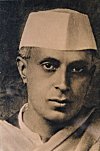Goa's Freedom Struggle
Introduction
The Portuguese were the first to colonize parts of India, and were the last to leave. This web exhibit documents rare photographs of the resistance provided by Indians to the Portuguese since the arrival of Vasco da Gama till the surrender of Portuguese troops in 1961.
Photographs are from V.N. O'key Collection and Kamat Picture Archive.
Contributor: Vikas Kamat
Early Resistances
In the process of establishing the Portuguese rule in Goa in 1510 A.D., Alfonso Albuquerque exploited and oppressed the local Goans, and many citizens rebelled against him. However, they were brutally punished, and their properties confiscated.
In 1787, some leading priests organized what has come to be known as "Pinto Revolt". This rebellion suffered due to leakage of news and disorganization. This effort was inspired by the French Revolution, and was aimed at establishing "liberty, equality and fraternity" in Goa.
In 1840, the British supported some rebels in the hope of destabilizing Goa.
The Ranes of Goa
Between 1852 A.D. and 1912 A.D. fourteen different rebellions were sprung by the locals against the Portuguese. Dipaji Rane carried the fight for four years and was able to extract several discounts and leniencies from the Portuguese.
Vikas Kamat/Kamat's Potpourri
Dada Rane and his Soldiers
Dada Rane in 1895 organized an armed rebellion against the Portuguese atrocities
Ram Monohar Lohia and 18th June 1946
After Portugal came under the dictatorship of Antonio Salazar in 1932, the repression extended to Goa with press censorship, suspension of laws and autocratic rule of the Governor of Goa. The rest of India at this time was caught in the electrifying mood for freedom from the British, and the great socialist leader Ram Manohar Lohia thought that Goa should also be part of the struggle and be free from Portuguese rule. On 18th of June in 1946, he called for a gathering of Goans in Madgao (Margoa) to agitate against the suspension of civil liberties. This idea appealed to the people of Goa who, inspired by the leadership of Mahatma Gandhi, were dreaming about becoming a part of free India. Thousands of people showed up in downtown Margoa, causing logistical and law and order problems for the administration.
Vikas Kamat/Kamat's Potpourri
Satyagraha of 18th June 1946, Goa
The Portuguese tried to disperse the crowds, and prevent Lohia from addressing. But Lohia preferred to defy the Portuguese and courted arrest, a peaceful protest strategy that had become popular in India.
Dr. Lohia truly kindled the flame of freedom in the hearts of the Goan people, as a result of which all shops and business establishments put down their shutters and expressed their solidarity with the cause. Eighteen June 1946 thus remains a memorable and sacred day in the history of Goa [1]. An important road in Goa today (year 2006) is named "18th June" road.
Efforts to Find a Peaceful Exit
Subsequent to the high drama of 1946, the Portuguese tightened the control against the Satyagrahis, but leaders like T.B. Cunha kept the movement alive. After India became free in 1947, the Government of India lobbied the Government of Portugal very hard to relinquish Goa, but the efforts were ignored, and even ridiculed.
For fourteen years even after British left India, Goa continued to be under Portuguese
rule. Many organizations started to liberate Goa, their means and tactics
differing in approach. Some of these organizations were Azad Gomantak Dal, the United Front of Goans, the Goa Liberation Council, the Goan People's Party,
and the Quit Goa Organization. Of course, the Indian National Congress and
Praja Socialist Party continued to lead the
fight, but no breakthrough seemed possible, due to Nehru's inability to bring
international pressure on Salazar and his own peaceful policies.
Unification with Rest of India
Amidst this tense situation, one day October of 1961, a Indian fisherman from Anjadiv Island was fired upon by a careless Portuguese policeman on a trivial accusation. In support of the fishermen, India moved India moved naval vessels in the proximity of Goa, which were also fired upon. Nehru's cabinet, who was frustrated at the apathy shown to its diplomatic and peaceful initiative by the Portuguese Government, and under heavy domestic pressure to take action, ordered shelling of Goa and began a military operation.
Vikas Kamat/Kamat's Potpourri
Portuguese Soldiers Surrendering to Indian Army
Display from Government Museum, Panaji
When the Indian military moved in to Goa, they were welcomed by the citizens and the Portuguese surrendered (Dec. 19, 1961) without much resistance.
Eventually Goa was accorded statehood in India.
Table of Contents
- Acharya Kripalani Leading an Agitation for Freedom
- Commandos of the Azad Gomantak Dal
- Dada Rane and his Associates
- Dada Rane and his Soldiers
- Defeat of the Portuguese Army
- Dipaji Rane
- Hirve Guruji - A Martyr for Goa
- March of Satyagrahis in Goa
- People of Goa in a Satyagraha for Freedom
- Pictures of Goa's History and Freedom Struggle
- Portuguese Soldiers Surrendering to Indian Army
- Portuguese Prisoners of War
- A Reminder that Goa is Not Yet Free
- Satyagraha of 18th June 1946, Goa
- Surrender of Portuguese Goa
- Violence During 18th June 1946 Protest
References
- Lambert Mascarenhas, "Goa's Freedom Movement", Published in Goacom Website, November 2006
- Museum Exhibit at the Government Museum, Panjim, February 2006
- Wikipedia Articles on Pintos Revolt, Portuguese India
![]()
See Also:
- Tryst with Destiny -- The story of India's struggle for freedom remains as a guiding light for resolving the various conflicts around the globe




